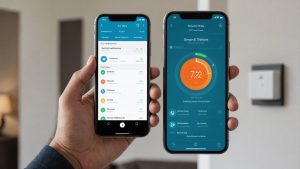Introduction
In an age where technology seamlessly integrates with our daily lives, smart homes are becoming increasingly popular. Among the many innovations, smart home blinds and shades stand out for their convenience and energy-saving benefits. Controlled through your smartphone, these devices offer a new level of ease and efficiency. This article will delve into effective techniques for using your smartphone to control smart home blinds and shades, guiding you through the setup, operation, and benefits of this modern convenience.
Also read : How to Use Your Smartphone to Control and Monitor a Smart Home Irrigation System?
Setting Up Your Smart Home Blinds and Shades
Before you begin controlling your smart home blinds and shades with your smartphone, you must first set up the system. This initial step is crucial to ensure a smooth and seamless operation.
Choosing the Right System
Have you seen this : What Are the Methods to Use Your Smartphone for Real-Time Smart Home Lighting Control?
Selecting the appropriate smart blinds and shades system is the first step in setup. Various brands and models are available, each with unique features and compatibility options. Consider factors such as:
- Compatibility: Ensure the system is compatible with your existing home automation setup.
- App Usability: The accompanying smartphone app should be user-friendly and intuitive.
- Connectivity: Opt for systems that offer stable and reliable connectivity, such as Wi-Fi or Bluetooth.
Installation
Once you’ve chosen the right system, follow the manufacturer’s instructions for installation. While some systems may require professional installation, many are designed for easy DIY setup. Ensure all components are securely installed and functional.
Connecting to Your Smartphone
After installing the blinds and shades, the next step is to connect them to your smartphone. This typically involves:
- Downloading the App: Install the specific app associated with your smart blinds and shades system.
- Pairing the Device: Use the app to pair your smartphone with the smart blinds. This may involve scanning a QR code or entering a unique code.
- Configuring Settings: Customize the settings within the app to suit your preferences. This includes setting schedules, adjusting light levels, and more.
By completing these steps, you ensure that your smart blinds and shades are ready for optimal control via your smartphone.
Using Voice Commands for Hands-Free Operation
Smart home technology often integrates with voice assistants, providing an additional layer of convenience. Using voice commands to control your smart blinds and shades offers a hands-free solution that enhances your overall smart home experience.
Integrating Voice Assistants
To take advantage of voice control, you will need to integrate your smart blinds and shades with a compatible voice assistant, such as Amazon Alexa, Google Assistant, or Apple Siri. This integration process typically involves:
- Enabling Skills: In the voice assistant app, enable the specific skill or action associated with your smart blinds and shades system.
- Linking Accounts: Connect your smart blinds and shades account with your voice assistant account.
- Naming Devices: Assign specific names to your blinds and shades within the voice assistant app to allow for easy identification and control.
Voice Command Examples
Once integrated, you can use various voice commands to control your blinds and shades. Some examples include:
- “Alexa, close the living room blinds.”
- “Hey Google, open the bedroom shades halfway.”
- “Siri, set the kitchen blinds to 50%.”
Using voice commands enhances the accessibility and convenience of your smart home blinds and shades, allowing you to control them without lifting a finger.
Automating Blinds and Shades for Energy Efficiency
One of the significant advantages of smart home technology is the ability to automate various tasks, including the operation of blinds and shades. Automation not only adds convenience but also contributes to energy efficiency.
Setting Schedules
By setting schedules, you can automate the opening and closing of your blinds and shades based on specific times of the day. For instance:
- Morning Routine: Program your blinds to open gradually in the morning, allowing natural light to wake you up gently.
- Evening Routine: Set your blinds to close at sunset, providing privacy and insulation.
Utilizing Sensors
Many smart blinds and shades systems offer integration with sensors, such as light and temperature sensors. These sensors allow for dynamic adjustments based on real-time conditions:
- Light Sensors: Automatically adjust the blinds based on the level of natural light, optimizing indoor lighting and reducing the need for artificial light.
- Temperature Sensors: Close the blinds during the hottest part of the day to keep your home cool, reducing the load on your air conditioning system.
Smart Home Ecosystem Integration
Integrating your smart blinds and shades with a broader smart home ecosystem can further enhance energy efficiency. For example:
- Smart Thermostats: Coordinate your blinds and shades with your smart thermostat to optimize heating and cooling.
- Smart Lighting: Sync your blinds and shades with smart lighting systems to create the perfect ambiance while minimizing energy use.
By automating your smart home blinds and shades, you can achieve significant energy savings while enhancing the comfort and convenience of your living space.
Troubleshooting Common Issues
While smart home technology offers numerous benefits, it is not without its challenges. Knowing how to troubleshoot common issues ensures that you can maintain optimal functionality of your smart blinds and shades.
Connectivity Issues
One of the most common problems with smart blinds and shades is connectivity issues. If you experience difficulty connecting your smartphone to the system, try the following:
- Check Wi-Fi/Bluetooth: Ensure that your smartphone and smart blinds are connected to the same Wi-Fi network or within Bluetooth range.
- Restart Devices: Restart both your smartphone and smart blinds system to reset the connection.
- Firmware Updates: Make sure both the app and the smart blinds system have the latest firmware updates installed.
App Malfunctions
App malfunctions can disrupt the operation of your smart blinds and shades. To resolve app-related issues:
- Reinstall the App: Uninstall and then reinstall the app to ensure a fresh start.
- Clear Cache: Clear the app’s cache to remove any temporary files that may be causing issues.
- Contact Support: If problems persist, contact the manufacturer’s customer support for assistance.
Mechanical Problems
Mechanical problems can also affect the operation of your smart blinds and shades. Address these issues by:
- Checking Alignment: Ensure that the blinds and shades are properly aligned and not obstructed.
- Inspecting Motors: Verify that the motors are functioning correctly and not making unusual noises.
- Regular Maintenance: Regularly clean and maintain the blinds and shades to prevent dust and debris from causing mechanical issues.
By effectively troubleshooting these common issues, you can ensure the continuous and efficient operation of your smart home blinds and shades.
The Future of Smart Home Blinds and Shades
The future of smart home blinds and shades looks promising, with continuous advancements in technology and integration. Staying informed about these developments can help you make the most of your smart home system.
Advancements in Automation
Future advancements in automation will likely focus on increased customization and intelligence. Expect more sophisticated sensors and algorithms that can learn your preferences and adjust the blinds and shades accordingly.
Enhanced Integration
Integration with other smart home devices will continue to improve. Future systems may offer seamless interoperability with a wider range of devices, creating a more cohesive and efficient smart home ecosystem.
Sustainability
As sustainability becomes a growing concern, future smart home blinds and shades will likely emphasize eco-friendly materials and energy-efficient designs. Innovations in solar-powered blinds and shades could further reduce energy consumption.
User Experience
The user experience will remain a key focus, with future developments aiming to make smart home technology even more intuitive and accessible. Expect improvements in app interfaces, voice control, and overall ease of use.
By staying informed about these trends, you can ensure that your smart home blinds and shades remain on the cutting edge of technology, providing maximum convenience and efficiency.
Conclusion
Controlling your smart home blinds and shades via your smartphone offers an unparalleled level of convenience and efficiency. By following the techniques outlined in this article, you can easily set up, operate, and troubleshoot your system. From integrating voice commands and automating for energy efficiency to staying abreast of future trends, these strategies will help you make the most of your smart home blinds and shades. Embrace this modern convenience to enhance your home’s functionality, comfort, and sustainability.











